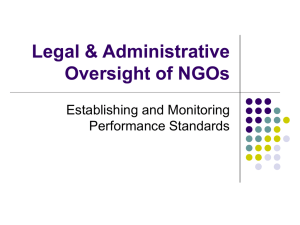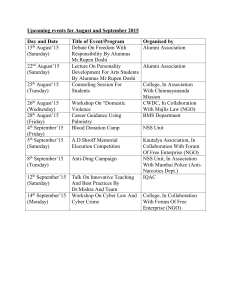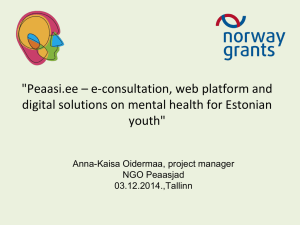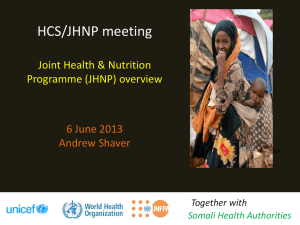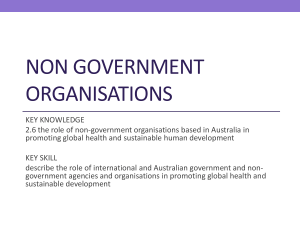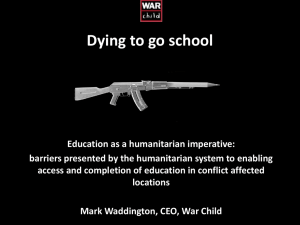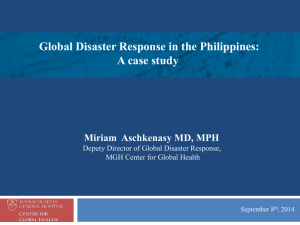Saving Lives Together
advertisement
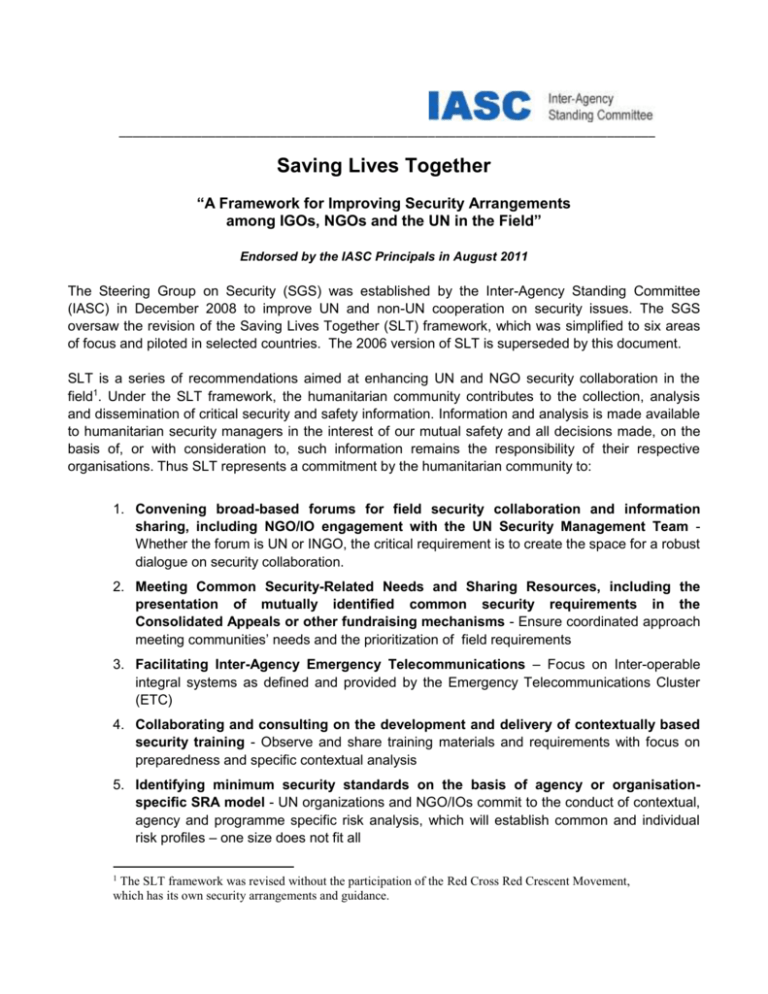
______________________________________________________________________________ Saving Lives Together “A Framework for Improving Security Arrangements among IGOs, NGOs and the UN in the Field” Endorsed by the IASC Principals in August 2011 The Steering Group on Security (SGS) was established by the Inter-Agency Standing Committee (IASC) in December 2008 to improve UN and non-UN cooperation on security issues. The SGS oversaw the revision of the Saving Lives Together (SLT) framework, which was simplified to six areas of focus and piloted in selected countries. The 2006 version of SLT is superseded by this document. SLT is a series of recommendations aimed at enhancing UN and NGO security collaboration in the field1. Under the SLT framework, the humanitarian community contributes to the collection, analysis and dissemination of critical security and safety information. Information and analysis is made available to humanitarian security managers in the interest of our mutual safety and all decisions made, on the basis of, or with consideration to, such information remains the responsibility of their respective organisations. Thus SLT represents a commitment by the humanitarian community to: 1. Convening broad-based forums for field security collaboration and information sharing, including NGO/IO engagement with the UN Security Management Team Whether the forum is UN or INGO, the critical requirement is to create the space for a robust dialogue on security collaboration. 2. Meeting Common Security-Related Needs and Sharing Resources, including the presentation of mutually identified common security requirements in the Consolidated Appeals or other fundraising mechanisms - Ensure coordinated approach meeting communities’ needs and the prioritization of field requirements 3. Facilitating Inter-Agency Emergency Telecommunications – Focus on Inter-operable integral systems as defined and provided by the Emergency Telecommunications Cluster (ETC) 4. Collaborating and consulting on the development and delivery of contextually based security training - Observe and share training materials and requirements with focus on preparedness and specific contextual analysis 5. Identifying minimum security standards on the basis of agency or organisationspecific SRA model - UN organizations and NGO/IOs commit to the conduct of contextual, agency and programme specific risk analysis, which will establish common and individual risk profiles – one size does not fit all 1 The SLT framework was revised without the participation of the Red Cross Red Crescent Movement, which has its own security arrangements and guidance. 6. Seeking adherence to Common Humanitarian Ground Rules (CHGR) - SLT recognizes that respect for common, locally developed ground rules for humanitarian action tailored for specific field locations enhances staff and operational security. CHGR seek to ensure that humanitarian assistance should not be instrumentalised by political or military agendas, should maintain its impartial character and be proportionate and based on needs only. To complement the recommendations, the revised SLT provides an information-based and staged approach to UN/NGO/IO security collaboration with clearly defined roles and responsibilities with a focus on triggers for implementation based on agreed IASC mechanisms such as the Sub-Working Group on Preparedness’ Humanitarian Early Warning Service and the Sub-Working Group on Consolidated Appeals Process. To this end, the SLT recognizes three stages of SLT implementation: Informal, Intermediate and Full Spectrum based on the information required to undertake security decisions in a complex operational environment as delineated in the following table: REVISED SLT FRAMEWORK: STAGED APPROACH TO IMPLEMENTATION WITH ROLES AND RESPONSIBILITES Recommendation Informal Stage Intermediate Stage Full Spectrum Stage The ten original SLT recommendations have been distilled to six essential objectives Early warning/crisis prone Country listed on IASC Early Warning list is the trigger for SLT implementation Mounting or low intensity crisis – Country identified as in crisis and eligible for CAP or other funding mechanism for humanitarian intervention Open conflict/disaster – ongoing CAP or other humanitarian funding mechanism, massive crisis response/unmet identified need in insecure environment May include DPKO mission with Humanitarian mandate Information Requirement: The humanitarian community contributes to the collection and dissemination of critical security and safety information. Information and analysis is thus made available to humanitarian security managers in the interest of our mutual safety and all decisions made, on the basis of, or with consideration to, such information remains the responsibility of their respective organisations Information Requirement: Information sharing on incidents , text alerts or flashes, news reports - DO Initiates with agreement of NGO/IO SFPS Information Requirement: Systematic collection of incident reports and open source analysis. Regular trend analysis, coupled with basic scenario forecast. Information Requirement: Security Information Operations Centre (SIOC) quality detailed trend analysis on a monthly, quarterly, seasonal or as required basis, providing a comprehensive threat image including forecast that is often broken down by regions. 1) Convening broad-based forums for field security collaboration and information sharing, including NGO/IO engagement with the UN Security Management Team UN DO must ensure fora for security collaboration among all humanitarian actors at area, country and sub-office level are convened, at regular intervals, to address practical security issues of common concern – DO/HC NGO/IO SFPs Whether the forum is UN or INGO, the critical requirement is to create the space for a robust dialogue on security collaboration. UN security cell and/or INGO safety coordination platforms will provide the forum for joint analysis DO initiates SLT as an agenda item at UNSMT DO engages NGO/IOs Plug into DSS training unit and NGOs doing training NGO/IOs ID Focal points to represent security concerns Info share protocols agreed and put into practise Frequency increases to monthly or as required DSS engages NGO/IO security personnel in UN Security cell or UN participates in NGO safety coordination platform DO ensures that SLT is a agenda item at UNSMT & consideration given to inviting Senior Managers of the NGO/IOs to attend relevant portions of SMT meetings or that such security coordination requirements are met in other fora. SIOC or security cell and/or NGO safety coordination platform provide the forum for joint analysis Frequency increases to weekly/daily as mutually agreed to Regular NGO/IO participation in UN security cell or UN in INGO safety coordination platform support and guidance NGOs and the Red Cross Movement may participate in relevant meetings of the UN SMT on an ex-officio2, representative basis. SLTTF supports country level efforts SLTTF support and monitoring, identification and compilation of best practises and strategies 2 Ex officio here refers to the fact that representatives of non-UN organizations are not bound by, nor participate formally in, SMT decisions on UN security policy. Recommendation Informal Stage Intermediate Stage Full Spectrum Stage 2) Meeting Common Security-Related Needs and Sharing Resources, including the presentation of mutually identified common security requirements in the Consolidated Appeals or other fundraising mechanisms Preparation Stage Appeal or other funding means preparation – Security Cell with NGO/IO input or INGO safety coordination platform support and CAP guidance Ongoing appeal or other funding means with well conceived and developed UN/NGO/IO security projects within CAPs to cover the additional resources potentially required for enhanced collaboration on staff security by UN Agencies and NGO/IOs, such as telecommunications and security training. Ensure coordinated approach meeting communities’ needs not just one by one Prioritize field requirements Inventory of security requirements DSS/NGO/IO SFPs Potential security requirements identified in advance on basis of early warning scenario, i.e. natural disaster, conflict, etc. Liaison with Host Gov on preparations as required – DO in concert with HC, HCT, NGO/IO SFPs SLTTF engage IASC Early Warning and OCHA regarding potential appeals & alert field DO/HC ensures humanitarian coordination system includes Security component – security cell and/or INGO safety coordination platform support and guidance HC/DO/NGO/IO SFPs, backstop at HQ by the SLTTF Optimally the Security Cell and/or NGO safety coordination platforms defines the security requirements, otherwise an ad-hoc group should be convened Security cell and/or NGO safety coordination platforms support with SLTTF backstopping Constant assessment and reevaluation of requirements reflected in Appeal or other funding mechanism - Security cell and/or INGO safety coordination platform support with SLTTF backstopping Donor liaison by DO/HC/NGO/IOs on security needs Prioritize requirements & develop protocols for resource sharing - Security cell and/or INGO safety coordination platform support and guidance with SLTTF backstopping 3) Facilitating Inter-Agency Emergency Telecommunications3 Focus on inter-operable integral systems as defined/provided by the ETC Under the policy for UN Minimum Operating Security Standards (MOSS), WFP is the focal point for Security Telecommunications and advises the Security Management Network on policy and implementation of standards and services. Recommendation 3 The ETCF supported by the DO advocating with the relevant authorities for the use of telecommunication equipment; SLTTF HQ link with the ETC lead agency, UNHAS and WFP’s Fast Information Technology and Telecommunications Emergency and Support Team (Fittest) . Informal Stage The ETC, supported by the relevant UN body, usually DO, negotiating with the authorities a common, inter-agency frequency and importation of ICT equipment to facilitate greater interoperability for security collaboration for IASC organizations (UN organizations and operational NGO/IO) Humanitarian actors should actively participate in the ETC thereby committing to security collaboration using standard communication procedures and, to the extent possible, providing staff with compatible communication systems Through the ETC, the UN advocates for licences and frequencies granted and maintained Support the ETC to meet the requirement for the communities common and in-house communications ETC develops projects that are approved by the HC/HCT and included in the CAP or other Intermediate Stage Full Spectrum Stage Focus area #3 was updated in July 2011 at the request of the IASC Working Group in order to reflect the establishment of the global Emergency Telecommunications Cluster infrastructure ETC develops projects that are approved by the HC/HCT for inclusion in the CAP or other funding proposals for requirements: Security cell and/or INGO safety coordination platform support and guidance with relevant agency/org representation funding proposals providing services to the humanitarian community through the HCT DO/UNSMT or other liaise with ETC, WFP, UNHAS and FITTEST 4) Collaborating and Consulting on the development and delivery of contextually based Security Training Generation III CD-ROM and internet based application for both UN and INGOs operating in high risk environments to address global requirements, supported by contextual initiatives at country or local level Observe and share training materials and requirements with focus on preparedness and specific context – DO/FSCO, NGO/IO SFPs Give consideration to the development of training that focuses specifically on improving security collaboration – CSA/FSCO/NGO/IO Security trainers SLTTF compiles and disseminates relevant material and assesses training initiatives for feasibility 4 Seek to increase their capacity for security training at all levels & when feasible, pool necessary resources to conduct field security training – DO, NGO/IO SFPs, NGO security trainers, Security Cell and/or INGO safety coordination platform. Maintain all previous initiatives Carry out joint security training in collaboration and/or consultation with other agencies to the extent possible – Security Cell and/or INGO safety coordination platform support and guidance Additional training resources, such as DSS Field Support Service and/or security training. NGOs contribute to ensure efficacy of contextual training 5) Identifying Minimum Security Standards on the basis of Agency or organisation-specific SRA model In recognition of the fact that programme and security are linked, UN organizations and NGO/IOs commit to the conduct of contextual, agency and programme specific risk analysis, which will establish common and individual risk profiles. While individual risk profiles will differ there may be opportunities for a common approach to SOPs between UN agencies and NGO/IOs which should be exploited, taking into consideration already existing standards, principles, and/or guidelines for example the UN MOSS (Minimum Operational Security Standards which are binding for the members of the UN system) and Interaction’s Security Planning Guidelines”4. 6) Seeking Adherence to Common Humanitarian Ground Rules (CHGR) SLT recognizes that respect for common, locally developed ground rules for humanitarian action tailored for specific field locations enhances staff and operational security. CHGR seek to ensure that humanitarian assistance should not be instrumentalised by political or military agendas, should maintain its impartial character and be proportionate and based on needs only. The DO/NGO/IOs initiate discussion of development of CHGR applicable to local circumstances Moreover, every effort should be directed to ensuring the issue of programme criticality is addressed from the start given the link between programme and security. As the recommendation is contextual, this recommendation applies as is to all three stages.
